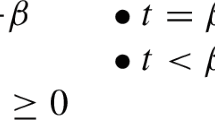Abstract
Negative probabilities were several times proposed in the literature as a way to reconcile violation of Bell-type inequalities with the premise of local realism. It is argued that instead of using negative probabilities that have no physical meaning one can use for this purpose fuzzy probabilities that have sound and unambiguous interpretation.
Similar content being viewed by others
References
Butnariu D., and Klement E.P. (1991). “Triangular norm-based measures and their Markov kernel representation”. J. Math. Anal. Appl. 162:111–143
Cereceda J.L., “Local hidden-variable models and negative-probability measures,” quant-ph/0010091 (2000).
Feynman R.P., “Negative probability,” mimeographed notes (n.d.).
Frank M.J. (1979). “On the simultaneous associativity of F(x,y) and x+y−F(x,y)”. Aequationes Math. 19:194–226
Giles R. (1976). “Łukasiewicz logic and fuzzy set theory”. Int. J. Man-Machine Studies 8:313–327
Han Y.D., Hwang W.Y., and Koh I.G. (1996). “Explicit solutions for negative-probability measures for all entangled states”. Phys. Lett. A 221:283–286
Home D., Lepore V.L., and Selleri F. (1991). “Local realistic models and non-physical probabilities”. Phys. Lett. A 158:357–360
Mesiar R., and Navara M. (1996). “T s -tribes and T s -measures”. J. Math. Anal. Appl. 201:91–102
Mückenheim W. (1986). “A review of extended probabilities”. Physics Reports 133:337–401
Mückenheim W. (1988). “An extended probability response to the Einstein–Podolsky–Rosen argument”. In: Selleri F. (eds). Quantum Physics Versus Local Realism. Plenum, New York, pp. 345–364
Pykacz J. (1994). “Fuzzy quantum logics and infinite-valued Łukasiewicz logic”. Int. J. Theor. Phys. 33:1403–1416
Pykacz J., and D’Hooghe B. (2001). “Bell-type inequalities in fuzzy probability calculus”. Int. J. Uncertainty, Fuzziness and Knowledge-Based Systems 9:263–275
Pykacz J., and Santos E. (1990). “Constructive approach to logics of physical systems: application to EPR case”. Int. J. Theor. Phys. 29:1041–1058
Pykacz J., and Santos E. (1991). “Hidden variables in quantum logic approach reexamined”. J. Math. Phys. 32:1287–1292
Pykacz J., and Santos E. (1995). “Bell-type inequalities on tensor products of quantum logics”. Found. Phys. Lett. 8:205–212
Rothman T., and Sudarshan E.C.G. (2001). “Hidden variables or positive probabilities?”. Int. J. Theor. Phys. 40:1525–1543
Santos E. (1986). “The Bell inequalities as tests of classical logics”. Phys. Lett. A 115:363–365
Sudarshan E.C.G. and Rothman T. (1993). “A new interpretation of Bell’s inequalities”. Int. J. Theor. Phys. 32:1077–1086
Zadeh L.A. (1965). “Fuzzy sets”. Information and Control 8:338–353
Zadeh L.A. (1968). “Probability measures of fuzzy events”. J. Math. Anal. Appl. 23:421–427
Zadeh L.A. (1976). “A fuzzy-algorithmic approach to the definition of complex or imprecise concepts”. Int. J. Man-Machine Studies 8:249–291
Author information
Authors and Affiliations
Corresponding author
Rights and permissions
About this article
Cite this article
Pykacz, J. “Solution” of the EPR Paradox: Negative, or Rather Fuzzy Probabilities?. Found Phys 36, 437–442 (2006). https://doi.org/10.1007/s10701-005-9025-9
Received:
Published:
Issue Date:
DOI: https://doi.org/10.1007/s10701-005-9025-9




